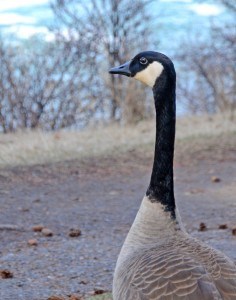

On a beautiful day last week a large flock of geese flew in a haphazard v-formation over Jasper, heading south. While part of me silently screamed IT’S NOT TIME YET, the reality is that day-length dictates their travel plans. It’s the same every year. And it’s time.
Where are they going? They’ll land anywhere from middle America to Northern Mexico, ravaging marshes, grasslands and grain fields in a loud, honking occupation that will last for the next six months. At least that’s what the back-to-nature geese will do.
The urban variety (there are two subspecies that specialize in city-living) will descend on school fields, government lawns and golf courses. Some will be hit in their little black heads with golf balls, a price the honking hoards seem willing to pay to chow down on the manicured green buffet. It’s the same thing that happens here in the spring, but in reverse.
Geese like lawns for a number of reasons. They can easily digest grass, so it’s an unending smorgasbord of fresh food. Lawns also offer parents an unobstructed view of predators that might be skulking around, hoping to land a gosling for dinner.
Given their apocalyptic numbers in some areas, it’s hard to believe that in the early 1900s, the Giant Canada Goose (the beefiest subspecies of them all) was at one point thought to be extinct. Their use as live decoys—clipping their wings and leaving them bobbing in the water to attract other birds—was in part responsible for their decline, along with hunting in general, and likely the rapid draining of prairie wetlands for agriculture.
Intensive and targeted plans to restore their numbers were wildly successful, to the point that they are now considered by some to be a pest. The sun rarely sets on the North American Empire of the Canada Goose, and, like the armies of other great empires, they’re pretty good at defending themselves.
If you’ve never been attacked by a Canada Goose, then you might think it’s nothing to worry about. However, having witnessed an attack on an old boyfriend many years ago as we sat enjoying a picnic, I can tell you that they mean business. The goose came up behind him at a break-neck speed, all the while hissing and aggressively flapping its wings. I was laughing so hard that unfortunately I couldn’t warn him, and imagine his surprise when the goose started hammering his spine with enough force to make tiny, goose-mouth-sized rips in his shirt. His back was bruised.
The relationship didn’t last.
I’ve learned from that experience, and as a result I’d like to share with you other signs that geese are getting really mad and their target is you. Watch for: head pumping, honking (natch), and vibrating neck feathers. I’d actually like to see that last one, but from a safe distance, of course.
I’m making it sound like I don’t like geese, but I actually have a lot of respect for them. This is an animal that as an adult can intimidate predators twice its size, and has evolved specialized methods to pluck kernels of corn from the stalk. Here in Jasper, one tough-as-nails goose family evicted osprey from their nest on the Athabasca River—a nest about 10 metres off the ground. That takes chutzpah! What about the young, you ask? No worries, the parents just boot the goslings out of the nest while they still have enough down to slow their fall to the ground. Surprisingly, it works. Geese, apparently, are innovative.
It won’t be long before another gaggle of geese glide by, following the amazing compass that guides them back and forth across the continent. I can’t say I’m sad to see them go, and it’s not just their entitled attitude. There’s something melancholy about their appearance in the sky this time of year, like another chapter of the book has ended. It’s the kind of sad beauty that’s nice to look at, but you shouldn’t spend too much time thinking about.
Besides, they’ll be back soon enough, bullying muskrat out of their push-ups, pooping on the school lawn and attacking northern humans who venture too close to their nests.
Let’s enjoy the peace while we have it, and to the golfers heading south to play a few rounds, watch your back.
Niki Wilson
Special to the Fitzhugh
